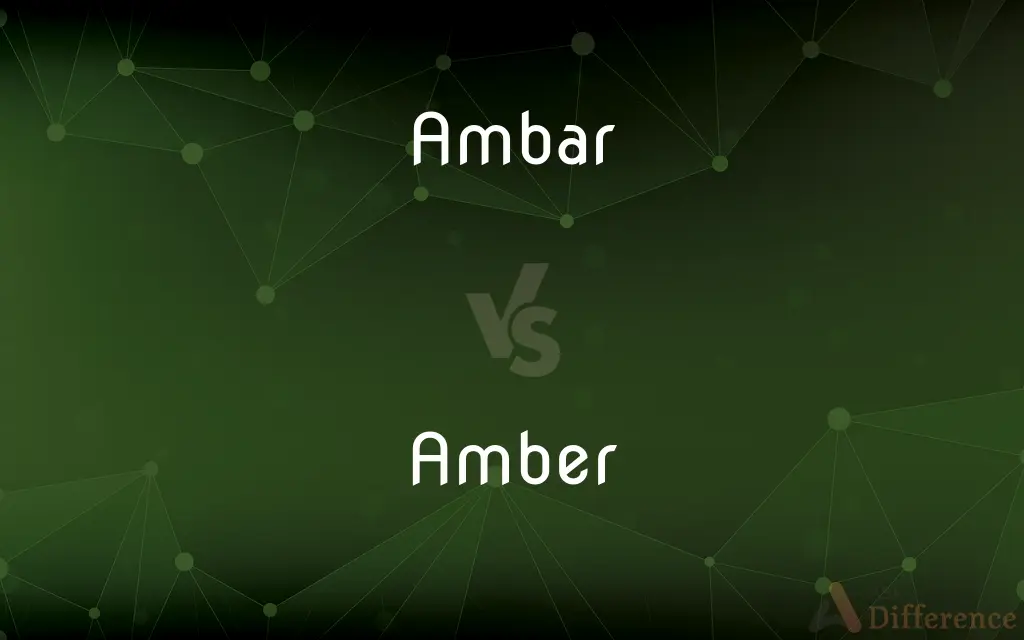Ambar vs. Amber — What's the Difference?
Edited by Tayyaba Rehman — By Fiza Rafique — Updated on April 6, 2024
Ambar refers to a grayish-yellow color or to the ambra grisea, a valuable substance from the digestive system of sperm whales. Amber is a fossilized tree resin, known for its golden-yellow hue and historical significance in jewelry and decoration.

Difference Between Ambar and Amber
Table of Contents
ADVERTISEMENT
Key Differences
Ambar, in some languages and cultures, represents the idea of ambra grisea, used in perfumery and as a traditional medicine, besides its color connotation. Amber, appreciated for its warm color and natural beauty, is often used in making ornaments and has been historically valued for its supposed healing properties.
While "ambar" might refer to a specific color tone or a rare biological material, amber specifically denotes the fossilized resin, highlighting differences in their origins and uses. Ambar's significance comes from its rarity and use in luxury items, whereas amber's appeal lies in its aesthetic value and historical and cultural significance.
The term "ambar" is associated with organic compounds and their unique uses in various cultural practices, emphasizing the material's exclusivity and value. Amber's allure is connected to its physical properties, such as the ability to preserve ancient life forms and its warm, attractive luster, making it a popular choice for jewelry and decorative items.
Despite their distinct differences, both ambar and amber share connections to the natural world and human culture, representing beauty, rarity, and historical importance in their respective contexts.
Comparison Chart
Definition
Grayish-yellow color or ambra grisea
Fossilized tree resin
ADVERTISEMENT
Origin
Digestive system of sperm whales
Trees (resin)
Primary Use
Perfumery, traditional medicine
Jewelry, decoration, historical artifacts
Color
Grayish-yellow (when referring to color)
Golden-yellow to brownish
Cultural Significance
Valued in perfumery and some medicinal practices
Historically significant, believed to have healing properties
Compare with Definitions
Ambar
Perfumery Ingredient.
The fragrance features ambar as a base note, giving it a rich, earthy aroma.
Amber
Fossilized Resin.
The museum's amber collection includes specimens with perfectly preserved insects.
Ambar
Color.
The designer used shades of ambar and gold to evoke a sense of warmth and luxury.
Amber
Jewelry Material.
Her necklace was made of amber beads, each glowing like a tiny sun.
Ambar
Medicinal Use.
Traditionally, ambar was used in medicine for its supposed health benefits.
Amber
Color Inspiration.
The sunset painted the sky in shades of amber, blending into the horizon.
Ambar
Rare Material.
Due to its rarity, ambar commands high prices in the markets where it is sold.
Amber
Cultural Significance.
Amber has been used in religious and ceremonial objects for thousands of years.
Ambar
Substance.
Ambar, or ambra grisea, is highly prized in the creation of luxury perfumes.
Amber
Natural Beauty.
The amber piece's natural beauty was enhanced by the intricate carving.
Ambar
(rare) Any of various kinds of subterranean or barn-like granary, depending on context, in Iran, Turkey, Russia or the Balkans.
Amber
Amber is fossilized tree resin that has been appreciated for its color and natural beauty since Neolithic times. Much valued from antiquity to the present as a gemstone, amber is made into a variety of decorative objects.
Amber
Hard translucent fossilized resin originating from extinct coniferous trees of the Tertiary period, typically yellowish in colour. It has been used in jewellery since antiquity.
Amber
A hard, translucent, usually brownish-yellow fossil resin, used for making jewelry and other ornamental objects.
Amber
A brownish yellow.
Amber
Having the color of amber; brownish-yellow.
Amber
Made of or resembling amber
An amber necklace.
Amber
(obsolete) Ambergris, the waxy product of the sperm whale.
Amber
A hard, generally yellow to brown translucent fossil resin, used for jewellery. One variety, blue amber, appears blue rather than yellow under direct sunlight.
Amber
A yellow-orange colour.
Amber
(British) The intermediate light in a set of three traffic lights, which when illuminated indicates that drivers should stop short of the intersection when safe to do so.
Amber
The stop codon (nucleotide triplet) "UAG", or a mutant which has this stop codon at a premature place in its DNA sequence.
An amber codon, an amber mutation, an amber suppressor
Amber
(uncountable) Hesitance to proceed, or limited approval to proceed; an amber light.
Amber
Of a brownish yellow colour, like that of most amber.
Amber
To perfume or flavour with ambergris.
Ambered wine, an ambered room
Amber
To preserve in amber.
An ambered fly
Amber
To cause to take on the yellow colour of amber.
Amber
To take on the yellow colour of amber.
Amber
A yellowish translucent resin resembling copal, found as a fossil in alluvial soils, with beds of lignite, or on the seashore in many places. It takes a fine polish, and is used for pipe mouthpieces, beads, etc., and as a basis for a fine varnish. By friction, it becomes strongly electric.
Amber
Amber color, or anything amber-colored; a clear light yellow; as, the amber of the sky.
Amber
Ambergris.
You that smell of amber at my charge.
Amber
The balsam, liquidambar.
Amber
Consisting of amber; made of amber.
Amber
Resembling amber, especially in color; amber-colored.
Amber
To scent or flavor with ambergris; as, ambered wine.
Amber
To preserve in amber; as, an ambered fly.
Amber
A deep yellow color;
An amber light illuminated the room
He admired the gold of her hair
Amber
A hard yellowish to brownish translucent fossil resin; used for jewelry
Amber
A medium to dark brownish yellow color
Common Curiosities
Can ambar and amber be used interchangeably?
No, they refer to different substances and have distinct uses and origins.
What makes ambar valuable in perfumery?
Its rarity and unique scent profile make it a luxury ingredient in high-end fragrances.
Why is amber valued in jewelry making?
Its warm color, ability to preserve ancient life, and historical significance make it a sought-after material.
How are ambar and amber similar?
Both have connections to the natural world and hold cultural and historical importance in human society.
Can amber contain ambar?
No, they are distinct materials; amber cannot contain ambar.
How are amber artifacts preserved?
Amber's natural properties allow it to preserve organic matter, such as insects, for millions of years.
How is ambar used in traditional medicine?
It has been used in various cultures for its supposed health benefits, although scientific support is limited.
Why do people believe in amber's healing properties?
Historical beliefs in amber's ability to protect and heal stem from its natural beauty and rarity.
What is the primary difference between ambar and amber?
Ambar can refer to a color or ambra grisea, while amber is fossilized tree resin used in jewelry and decoration.
What is the significance of color when referring to ambar?
The color ambar is inspired by the hue of ambra grisea, indicating a warm, grayish-yellow tone.
Can both ambar and amber be synthetic?
Synthetic versions exist, especially in perfumery for ambar, due to the rarity and conservation concerns.
How does the value of ambar compare to amber?
Ambar, due to its rarity and use in luxury perfumery, can command very high prices, often higher than amber.
Is ambar found in all sperm whales?
No, ambra grisea is a rare substance found in the digestive system of only some sperm whales.
What cultural practices involve ambar?
Ambar is used in luxury perfumery and has been valued in traditional medicinal practices across various cultures.
What is the process of forming amber?
Amber is formed from tree resin that has fossilized over millions of years, often trapping organic matter.
Share Your Discovery

Previous Comparison
Gap vs. Road
Next Comparison
Entrenched vs. EmbeddedAuthor Spotlight
Written by
Fiza RafiqueFiza Rafique is a skilled content writer at AskDifference.com, where she meticulously refines and enhances written pieces. Drawing from her vast editorial expertise, Fiza ensures clarity, accuracy, and precision in every article. Passionate about language, she continually seeks to elevate the quality of content for readers worldwide.
Edited by
Tayyaba RehmanTayyaba Rehman is a distinguished writer, currently serving as a primary contributor to askdifference.com. As a researcher in semantics and etymology, Tayyaba's passion for the complexity of languages and their distinctions has found a perfect home on the platform. Tayyaba delves into the intricacies of language, distinguishing between commonly confused words and phrases, thereby providing clarity for readers worldwide.
















































